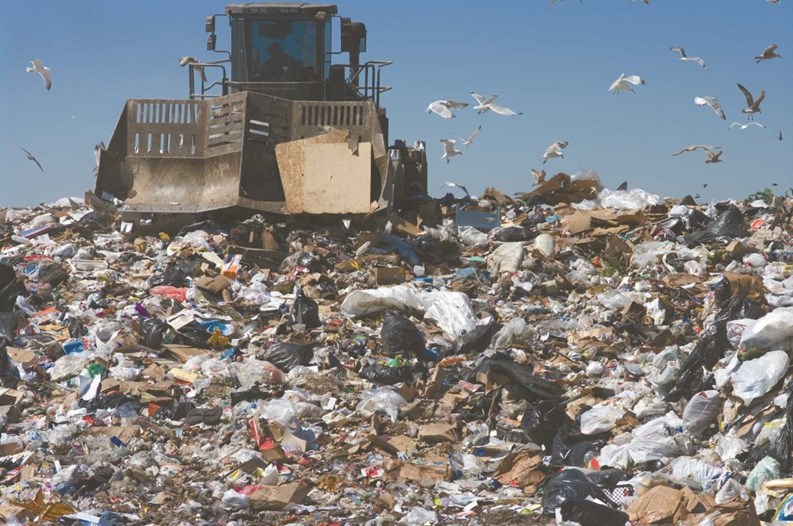We've heard all the New Jersey jokes, and though we might be insulted, we've probably told some ourselves. From Benjamin Franklin to George Carlin, New Jersey has been the on the receiving end of such questions as, “Why does New Jersey have more landfills, and California have more lawyers” or declarations of “the Garden State... if you’re growing smokestacks.”
For centuries, New Jersey has been much maligned for its vital and lucrative role as the dumping ground between New York and Philadelphia. Things have changed though and during the past two decades, we've seen New Jersey, sometimes known as “The Landfill of Opportunity,” take that nickname all the way to the bank.
In the early 1990s, the state of New Jersey created a near monopoly out of the waste disposal business, disposing of all of its own garbage as well as that of the states of New York and Pennsylvania. By 2000, privatization of waste management had become the norm and garbage had become “a commodity to be traded anywhere,” according to Walter Porter, a spokesperson for the New Jersey Department of Environmental Protection (NJDEP).
Porter explains that, “in 1996, state policy was stricken down in court as being an impediment to interstate commerce. As a result, solid waste now travels in and out of New Jersey on a daily basis.”
According to Porter, New Jersey disposal facilities are highly competitive with other out-of-state facilities and as a result both the tipping fees (fees charged to trash haulers to dispose of their trash, usually charged per ton) and the cost for waste disposal have gone down in recent years. This is grown advantageous to residents and the industry alike. Communities in New Jersey are able to take advantage of low landfill rates in Pennsylvania as well as accept money to handle garbage from New York.
New Jersey has collected an estimated 20 million tons of black, blue, and clear bags. Once collected not many of us think about or even know where that trash goes. More often than not, those who do, having endured the Jersey jokes, think of New Jersey’s many landfills. They would be one-third right, today our garbage is dealt with in one of three ways: transfer stations; resource recovery facilities or landfills.
The Resource Recovery Facility
Resource recovery facilities, also known as “co-generation” or “waste-to-energy plants,” are designed to burn solid waste but also turn the heat to electricity, leaving a much smaller volume of ash to be buried. These facilities are not to be confused with the pollution-creating incinerators of the 1970s.
These are much cleaner than the incinerators of yesteryear and under the scrutiny of the NJDEP, it is believed that resource recovery facilities pose low threats to human health and minimize the impact of trash generation.
Trucks bring the solid waste into a tipping area and unload the trash into a large pit. A crane sorts out any inappropriate material, and then moves the trash into a combustion chamber where it is burned. A boiler recovers the heat generated from the combustion process, and the resultant steam is used for electric power generation. Two types of ash are produced—bottom ash and fly ash. Bottom ash is the heavier glass and metal pieces that do not burn and it accounts for about 75–90 percent of the ash created. Fly ash rises with hot gases and is captured by emission control equipment in the stacks.
According to the NJEP, in addition to energy generation, this burning process reduces the toxicity of organic compounds in the waste and reduces its volume by as much as 90 percent, which makes the material safer to dispose of than untreated hazardous waste. And the reduced volume allows landfills to use space more efficiently.
One of the larger of these facilities is the Covanta Essex facility in Newark. Opened in 1990, the facility serves the needs of 22 municipalities in Essex County. According to Elizabeth Howard, a spokesperson for Covanta, “The plant is owned and operated under a long-term agreement with the Port Authority of NY & NJ. The plant opened in 1990 and today it processes 2,800 tons per day of municipal waste and generates approximately 500 million kilowatts of electricity each year. Some of this electricity is sold to the local power grid which provides power to 50,000 homes while the remaining electricity is used to operate the plant itself.”
Next Stop: Transfer Stations
Once the trucks, which hold a little over 10 tons of waste, are filled, they go to the nearest transfer station. There the solid waste is processed and loaded onto trucks or sealed rail containers for transfer to other states. There are currently over 50 transfer stations in New Jersey.
The prevailing thought is that combining the loads of several individual waste collections into single larger shipments saves communities money on labor and operating costs. This in turn also reduces the total number of trips traveling to and from the disposal sites. It is believed that this consolidation of garbage reduces air emissions and energy use ultimately lowering the cost of solid waste management services.
According to Midco Waste Systems, “One might think of transfer stations as a form of car-pooling for garbage.” This consolidation of refuse allows the company to transport larger volumes with fewer trucks. Thus, Midco can minimize wear and tear on its vehicles and the local roads, all the while creating lower emissions and increasing efficiency, according to the company.
Waste is usually moved off site in a matter of minutes or hours, usually sorted, but not always. From there it is compacted for long distance transfer to landfills in six different states, but most likely is deposited in one of New Jersey’s 14 landfills or one of Pennsylvania’s 47.
The Landfill
What is a landfill? The NJDEP describes it as a “specially-designed depression in the ground for the disposal of solid waste…constructed so that it will reduce or prevent potential hazards to public health and safety, as well as the environment.”
Over the last 30 years modern landfills been redesigned in an effort to prevent the contamination and other environmental hazards attributed to older landfills. These landfills were simply no more than large holes usually dug in wetlands with very little consideration given to their long term effect.
Back then when rain or snow came in contact with solid waste in the landfill a liquid called “leachate” was created. The more contact between water and waste occurred the more it became contaminated. When landfills leaked, this contaminated liquid moved throughout the soil and rock beneath the landfill polluting the groundwater or nearby streams.
Today landfill construction standards have been updated to prevent this from occurring. New landfills now require a clay foundation and impermeable lower liners be installed to block the movement of leachate. This has been described as “bathtub within a bathtub” with the second bathtub providing double insurance that liquids won’t be able to leak from the landfill. Today it is further required that a leachate collection system be constructed and that groundwater around the landfill be monitored with monitoring wells. At the end of each day soil and other materials such as broken glass or oily soils, are used to cover the garbage packed into the landfill. This is done to combat odors, rodents, birds and other pests. This “cover” also absorbs rainwater and helps reduce the amount of leachate resulting from rain or snowfall.
New and Improved
According to the Robert Aiello, a spokesperson for the Environmental Protection Agency (EPA), “Many landfills are also constructed with separate cells or compartments that help with maintenance and environmental protection.” Additionally, when solid waste in the landfill begins to “break down” or decompose a gas called methane gas is created.
Gravel layers are added to the landfill to allow the gas to escape from the waste to the surface through plastic piping. In the past the gas was “flared” or burned to prevent odors and explosions. Today the gas produced by landfills is collected and can be used to heat boilers and generate heat and light for certain landfill operations. On average landfills are in use between 20 and 30 years.
When a landfill has reached its full it is “capped.” This involves layering clay, a liner, soil and vegetation on top. Landfills are now designed with possible end uses in mind. Once closed, these landfills can be converted into golf courses, shopping centers, malls and parks. There are 578 landfills in New Jersey with twelve of them still in operation but that is about to change.
Buried in the Meadowlands?
One most famous story of a “local landfill does good” is that of the Meadowlands Stadium. Carrying on that legacy, in May 2012, Public Service Electric and Gas (PSE&G) joined the New Jersey Meadowlands Commission (NJMC) and SunDurance Energy to dedicate the Kearny Landfill Solar Farm, the first solar project on a state-owned landfill. The 3-megawatt installation is part of PSE&G’s Solar 4 All™ program and was built on a 13-acre capped section of the closed NJMC 1A landfill.
The project is a joint effort between PSE&G, the NJMC, which manages the landfill, and SunDurance Energy, an Edison-based solar developer, that oversaw the construction. The project was also funded by an $8.5 million New Jersey Board of Public Utilities (NJBPU) American Recovery and Reinvestment Act State Energy Program grant awarded to the NJMC
According to PSE&G’s president, Ralph LaRossa, the installation of more than 12,500 solar panels on the closed landfill illustrates how clean energy projects can breathe new life into otherwise unusable sites. “This project opens a new chapter in New Jersey lore,” LaRossa said. “These landfills have sat dormant for years, and have been a familiar site to northern New Jersey residents for as long as I can remember. This project updates that story, showing how 21st century technology coupled with public-private partnerships can return even the most unusable space to a productive purpose.”
Additionally, PSE&G's Kearny Landfill Solar Farm joins three other PSE&G Solar 4 All projects (in Linden, Trenton and Edison) that utilize brownfields. (The EPA defines a brownfield as “a property, the expansion, redevelopment, or reuse of which may be complicated by the presence or potential presence of a hazardous substance, pollutant, or contaminant.”) Another brownfield solar farm is currently in development on PSE&G property in Hackensack. Power from the Kearny Meadowlands Landfill Solar Farm flows directly to the electric grid for the benefit of all PSE&G electric customers.
PSE&G‘s Solar 4 All is a $450 million program to develop 80 megawatts of solar capacity. Divided into two segments, the program first consists of developing more than 20 centralized solar installations and includes the Kearny Landfill Solar Farm. In addition to installing up to 40 megawatts of pole-attached solar panels in neighborhoods on utility poles in PSE&G’s service territory.
According to LaRossa this project is “helping New Jersey reach its renewable energy goals and increasing the state’s reputation as a national leader in solar development.”
From now on when you're rudely awakened by the sound of a garbage truck, you now know that your garbage is going off to a better place. And even if the New Jersey jokes never go away, the Garden State will still be laughing all the way to the bank.
J.M. Wilson is a freelance writer and a frequent contributor to The New Jersey Cooperator. Associate Editor Liam P. Cusack contributed to this article.







Leave a Comment